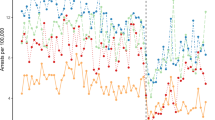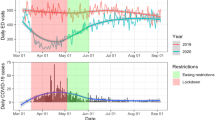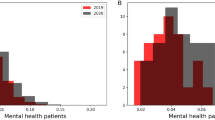Abstract
Under the Stop, Question, and Frisk (SQF) policy, New York City (NYC) police stopped Black Americans at more than twice the rate of non-Hispanic whites, after controlling for arrests and precinct differences. We examined whether police stops of Black Americans during SQF correspond positively with psychiatric emergency department (ED) visits among Black residents in NYC. We utilized as the exposure all police stops, stops including frisking, and stops including use of force among Black Americans in NYC between 2006 and 2015 from the New York City Police Department’s New York City—Stop, Question, and Frisk database. We examined 938,356 outpatient psychiatric ED visits among Black Americans in NYC between 2006 and 2015 from the Statewide Emergency Department Database (SEDD). We applied Box-Jenkins time-series methods to control for monthly temporal patterns. Results indicate that all stops, frisking, and use of force of Black residents correspond with increased psychiatric ED visits among Black Americans in NYC (all stops—coef = 0.024, 95%CI = 0.006, 0.043; frisking—coef = 0.048, 95%CI = 0.015, 0.080; use of force—coef = 0.109, 95%CI = 0.028, 0.190). Our findings indicate that a one standard deviation increase in police stops equates to a 2.72% increase in psychiatric ED visits among Black residents in NYC. Use of force may have the greatest mental health consequences due to perceived threats of physical violence or bodily harm to other members of the targeted group. Racially biased and unconstitutional police encounters may have acute mental health implications for the broader Black community not directly involved in the encounter itself.


Similar content being viewed by others
Data Availability
Aggregated datasets and/or code provided upon request from the corresponding author.
References
Report: NYPD stop-and-frisk activity. New York Civil Liberties Union. Published May 8, 2012. Accessed April 27, 2021. https://www.nyclu.org/en/publications/report-nypd-stop-and-frisk-activity-2011-2012
Gelman A, Fagan J, Kiss A. An analysis of the New York City Police Department’s “stop-and-frisk” policy in the context of claims of racial bias. J Am Stat Assoc. 2007;102(479):813–23. https://doi.org/10.1198/016214506000001040.
Ridgeway G. Analysis of racial disparities in the New York Police Department’s stop, question, and frisk practices. Santa Monica, CA: RAND Corporation; 2007.
Levchak PJ. Stop-and-frisk in New York City: estimating racial disparities in post-stop outcomes. J Crim Just. 2021;73: 101784. https://doi.org/10.1016/j.jcrimjus.2021.101784.
Sewell AA, Jefferson KA. Collateral damage: the health effects of invasive police encounters in New York City. J Urban Health. 2016;93:42–67.
Broken Windows - The Atlantic. Published 1982. Accessed April 16, 2021. https://www.theatlantic.com/magazine/archive/1982/03/broken-windows/304465/
O’Brien DT, Farrell C, Welsh BC. Broken (windows) theory: a meta-analysis of the evidence for the pathways from neighborhood disorder to resident health outcomes and behaviors. Soc Sci Med. 2019;228:272–92. https://doi.org/10.1016/j.socscimed.2018.11.015.
O’Brien DT, Farrell C, Welsh BC. Looking through broken windows: the impact of neighborhood disorder on aggression and fear of crime is an artifact of research design. Ann Rev Criminol. 2019;2(1):53–71. https://doi.org/10.1146/annurev-criminol-011518-024638.
Harcourt B. Illusion of order: the false promise of broken windows policing. Faculty Books. Published online January 1, 2001. https://scholarship.law.columbia.edu/books/114. Accessed 27 Apr 2021.
Brunson RK, Miller J. Young black men and urban policing in the United States. Br J Criminol. 2006;46(4):613–40. https://doi.org/10.1093/bjc/azi093.
Kessler RC, Mickelson KD, Williams DR. The prevalence, distribution, and mental health correlates of perceived discrimination in the United States. J Health Soc Behav. 1999;40(3):208–30. https://doi.org/10.2307/2676349.
La Vigne N, Lachman P, Matthews A, Neusteter SR. Key issues in the police use of pedestrian stops and searches: (527872013–001). Published online. 2012. https://doi.org/10.1037/e527872013-001.
Smith, Voisin DR, Yang JP, Tung EL. Keeping your guard up: hypervigilance among urban residents affected by community and police violence. Health Aff. 2019;38(10):1662–1669. https://doi.org/10.1377/hlthaff.2019.00560
E. Lipscomb A, Emeka M, Bracy I, et al. Black male hunting! A phenomenological study exploring the secondary impact of police induced trauma on the Black man’s psyche in the United States. JSSW. 2019;7(1). https://doi.org/10.15640/jssw.v7n1a2
Alang S, McAlpine D, McClain M. Police encounters as stressors: associations with depression and anxiety across race. Socius. 2021;7:2378023121998128. https://doi.org/10.1177/2378023121998128.
Webb L, Jackson DB, Jindal M, Alang S, Mendelson T, Clary LK. Anticipation of racially motivated police brutality and youth mental health. Journal of Criminal Justice. Published online July 14, 2022:101967. https://doi.org/10.1016/j.jcrimjus.2022.101967
Turney K. Depressive symptoms among adolescents exposed to personal and vicarious police contact. Society and Mental Health. Published online July 3, 2020:2156869320923095. https://doi.org/10.1177/2156869320923095
Jackson DB, Del Toro J, Semenza DC, Testa A, Vaughn MG. Unpacking racial/ethnic disparities in emotional distress among adolescents during witnessed police stops. J Adolesc Health. Published online April 2021:S1054139X21001063. https://doi.org/10.1016/j.jadohealth.2021.02.021
Jahn JL, Agenor M, Chen JT, Krieger N. Frequent police stops, parental incarceration and mental health: results among US non-Hispanic Black and White adolescent girls and boys. J Epidemiol Community Health. Published online December 23, 2020:jech-2020–214578. https://doi.org/10.1136/jech-2020-214578
Jackson DB, Fahmy C, Vaughn MG, Testa A. Police stops among at-risk youth: repercussions for mental health. J Adolesc Health. 2019;65(5):627–32. https://doi.org/10.1016/j.jadohealth.2019.05.027.
Geller A, Fagan J, Tyler T, Link BG. Aggressive policing and the mental health of young urban men. Am J Public Health. 2014;104(12):2321–7. https://doi.org/10.2105/AJPH.2014.302046.
Kerrison EM, Sewell AA. Negative illness feedbacks: high-frisk policing reduces civilian reliance on ED services. Health Serv Res. 2020;55(S2):787–796. https://doi.org/10.1111/1475-6773.13554
Brayne S. Surveillance and system avoidance: criminal justice contact and institutional attachment. Am Sociol Rev. 2014;79(3):367–91. https://doi.org/10.1177/0003122414530398.
Sewell AA, Jefferson KA, Lee H. Living under surveillance: gender, psychological distress, and stop-question-and-frisk policing in New York City. Soc Sci Med. 2016;159:1–13. https://doi.org/10.1016/j.socscimed.2016.04.024.
Snowden LR, Catalano R, Shumway M. Disproportionate use of psychiatric emergency services by African Americans. Psychiatr Serv. 2009;60(12):1664–71.
Floyd, et al. v. City of New York, et al. Center for constitutional rights. Accessed July 16, 2022. https://ccrjustice.org/node/1765
Franzini L, Ribble JC, Keddie AM. Understanding the Hispanic paradox. Ethn Dis. 2001;11(3):496–518.
Neighbors HW, Trierweiler SJ, Ford BC, Muroff JR. Racial differences in DSM diagnosis using a semi-structured instrument: the importance of clinical judgment in the diagnosis of African Americans. J Health Soc Behav. 2003;44(3):237–56. https://doi.org/10.2307/1519777.
Neighbors HW, Jackson JS, Campbell L, Williams D. The influence of racial factors on psychiatric diagnosis: a review and suggestions for research. Community Ment Health J. 1989;25(4):301–11. https://doi.org/10.1007/BF00755677.
Garretson DJ. Psychological misdiagnosis of African Americans. J Multicult Couns Dev. 1993;21:119–26. https://doi.org/10.1002/j.2161-1912.1993.tb00590.x.
Barnes DM, Bates LM. Do racial patterns in psychological distress shed light on the Black-White depression paradox? A systematic review. Soc Psychiatry Psychiatr Epidemiol. 2017;52(8):913–28. https://doi.org/10.1007/s00127-017-1394-9.
Jackson JS, Knight KM, Rafferty JA. Race and unhealthy behaviors: chronic stress, the HPA axis, and physical and mental health disparities over the life course. Am J Public Health. 2010;100(5):933–9. https://doi.org/10.2105/AJPH.2008.143446.
Pamplin JR, Kezios KL, Hayes-Larson E, et al. Explaining the Black-white depression paradox: interrogating the Environmental Affordances Model. Soc Sci Med. 2021;277: 113869. https://doi.org/10.1016/j.socscimed.2021.113869.
Williams D, González H, Neighbors H, et al. Prevalence and distribution of major depressive disorder in African Americans, Caribbean blacks, and non-Hispanic whites: results from the National Survey of American Life. Arch Gen Psychiatry. 2007;64:305–15. https://doi.org/10.1001/archpsyc.64.3.305.
HCUP SEDD. Published 2019. Accessed July 24, 2020. https://www.hcup-us.ahrq.gov/db/state/sedddist/SEDD_Introduction.jsp
Singh P, Chakravarthy B, Yoon J, Snowden L, Bruckner TA. Psychiatric-related revisits to the emergency department following rapid expansion of community mental health services. Acad Emerg Med. Published online June 4, 2019. https://doi.org/10.1111/acem.13812
Bruckner TA, Singh P, Chakravarthy B, Snowden L, Yoon J. Psychiatric emergency department visits after regional expansion of community health centers. Psychiatr Serv. 2019;70(10):901–6. https://doi.org/10.1176/appi.ps.201800553.
Bruckner TA, Singh P, Yoon J, Chakravarthy B, Snowden LR. African American/white disparities in psychiatric emergencies among youth following rapid expansion of Federally Qualified Health Centers. Health Serv Res. 2020;55(1):26–34. https://doi.org/10.1111/1475-6773.13237.
County FIPS Codes | NRCS. Accessed July 20, 2021. https://www.nrcs.usda.gov/wps/portal/nrcs/detail/national/home/?cid=nrcs143_013697
Publications, Reports - NYPD. Accessed December 15, 2020. https://www1.nyc.gov/site/nypd/stats/reports-analysis/stopfrisk.page
Bor J, Venkataramani AS, Williams DR, Tsai AC. Police killings and their spillover effects on the mental health of black Americans: a population-based, quasi-experimental study. The Lancet. 2018;392(10144):302–10. https://doi.org/10.1016/S0140-6736(18)31130-9.
Das A, Singh P, Kulkarni AK, Bruckner TA. Emergency Department visits for depression following police killings of unarmed African Americans. Soc Sci Med. 2021;269: 113561. https://doi.org/10.1016/j.socscimed.2020.113561.
McCleary R, Hay R. Applied time series analysis for the social sciences. Thousand Oaks, CA: Sage Publications; 1980.
Catalano R, Serxner S. Time series designs of potential interest to epidemiologists. Am J Epidemiol. 1987;126(4):724–31.
Liu LM. Scientific Computing Associates Corp. Chicago, IL: Published online 2009.
Box G, Jenkins G, Reinsel G. Time series analysis: forecasting and control. 3rd ed. Englewood Cliff, NJ: Prentice Hall; 1994.
Trends in the utilization of emergency department services, 2009–2018. ASPE. Accessed October 28, 2022. https://aspe.hhs.gov/reports/trends-utilization-emergency-department-services-2009-2018
Fragile families and child wellbeing study. Accessed November 29, 2022. https://fragilefamilies.princeton.edu/
Monk EP. Linked fate and mental health among African Americans. Soc Sci Med. 2020;266: 113340. https://doi.org/10.1016/j.socscimed.2020.113340.
Harrell SP. A multidimensional conceptualization of racism-related stress: implications for the well-being of people of color. Am J Orthopsychiatry. 2000;70(1):42–57. https://doi.org/10.1037/h0087722.
Owens E, Rosenquist J. Racial and Identity Profiling act (RIPA) in the Los Angeles Police Department. Published online 2020. Accessed July 16, 2022. https://escholarship.org/uc/item/4mn75943
Theall KP, Francois S, Bell CN, Anderson A, Chae D, LaVeist TA. Neighborhood police encounters, health, and violence in a Southern City: study examines neighborhood police encounters, health, and violence in New Orleans, Louisiana. Health Affairs. 2022;41(2):228–36. https://doi.org/10.1377/hlthaff.2021.01428.
Farrell C. Policing gender, race, and place: a multi-level assessment of stop and frisks. Race Justice. Published online February 16, 2022:21533687221078970. https://doi.org/10.1177/21533687221078970
Crenshaw K. On intersectionality: essential writings. Faculty Books. Published online March 1, 2017. https://scholarship.law.columbia.edu/books/255
MacDonald J, Braga AA. Did Post-Floyd et al. Reforms reduce racial disparities in NYPD stop, question, and frisk practices? An exploratory analysis using external and internal benchmarks. Justice Q. 2019;36(5):954–983. https://doi.org/10.1080/07418825.2018.1427278
Black Lives Matter. Black Lives Matter. Published 2022. Accessed November 14, 2022. https://blacklivesmatter.com/about/
Ni MY, Kim Y, McDowell I, et al. Mental health during and after protests, riots and revolutions: a systematic review. Aust N Z J Psychiatry. 2020;54(3):232–43. https://doi.org/10.1177/0004867419899165.
Price JH, Khubchandani J. The changing characteristics of African-American adolescent suicides, 2001–2017. J Community Health. 2019;44(4):756–63. https://doi.org/10.1007/s10900-019-00678-x.
Taskforce on Black Youth Suicide and Mental Health | U.S. Representative Bonnie Watson Coleman. U.S. Congresswoman Bonnie Watson Coleman. Accessed May 7, 2021. https://watsoncoleman.house.gov/suicidetaskforce/
Ring the Alarm: the Crisis of Black Youth Suicide in America | Suicide Prevention Resource Center. Accessed September 23, 2021. https://www.sprc.org/news/ring-alarm-crisis-black-youth-suicide-america
Gili M, Castellví P, Vives M, et al. Mental disorders as risk factors for suicidal behavior in young people: a meta-analysis and systematic review of longitudinal studies. J Affect Disord. 2019;245:152–62. https://doi.org/10.1016/j.jad.2018.10.115.
Duron JF, Williams-Butler A, Mattson P, Boxer P. Trauma exposure and mental health needs among adolescents involved with the juvenile justice system. J Interpers Violence. Published online May 26, 2021:08862605211016358. https://doi.org/10.1177/08862605211016358
Shufelt JL, Cocozza JJ. Youth with mental health disorders in the juvenile justice system: results from a multi-state prevalence study. Delmar, NY: National Center for Mental Health and Juvenile Justice. 2006. https://www.ojp.gov/ncjrs/virtual-library/abstracts/youth-mental-health-disorders-juvenile-justice-system-results-multi. Accessed 27 Apr 2021.
Mesic A, Franklin L, Cansever A, et al. The relationship between structural racism and Black-White disparities in fatal police shootings at the state level. J Natl Med Assoc. 2018;110(2):106–16. https://doi.org/10.1016/j.jnma.2017.12.002.
Ross CT. A multi-level Bayesian analysis of racial bias in police shootings at the county-level in the United States, 2011–2014. Hills PJ, ed. PLoS One. 2015;10(11):e0141854. https://doi.org/10.1371/journal.pone.0141854
Acknowledgements
National Institute of Mental Health (1R21MH110815-01A1).
Author information
Authors and Affiliations
Contributions
AD developed the research question and conducted the analysis. AD wrote the first draft of the manuscript. TB assisted with the analysis, interpretation, and writing.
Corresponding author
Additional information
Publisher's Note
Springer Nature remains neutral with regard to jurisdictional claims in published maps and institutional affiliations.
Appendix
Appendix
Rights and permissions
Springer Nature or its licensor (e.g. a society or other partner) holds exclusive rights to this article under a publishing agreement with the author(s) or other rightsholder(s); author self-archiving of the accepted manuscript version of this article is solely governed by the terms of such publishing agreement and applicable law.
About this article
Cite this article
Das, A., Bruckner, T.A. New York City’s Stop, Question, and Frisk Policy and Psychiatric Emergencies among Black Americans. J Urban Health 100, 255–268 (2023). https://doi.org/10.1007/s11524-022-00710-x
Accepted:
Published:
Issue Date:
DOI: https://doi.org/10.1007/s11524-022-00710-x






